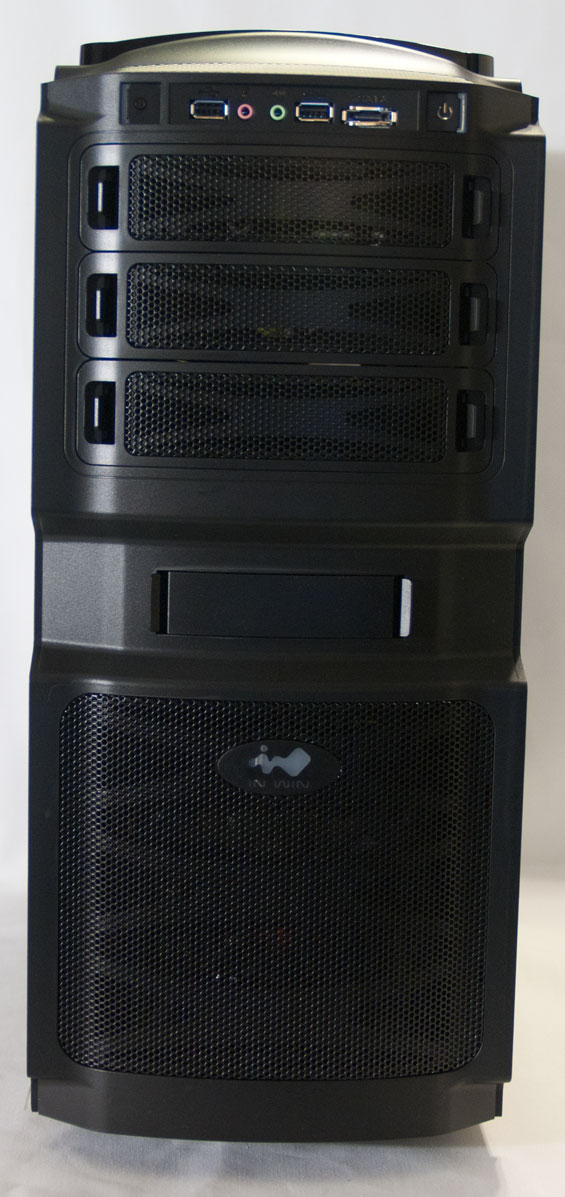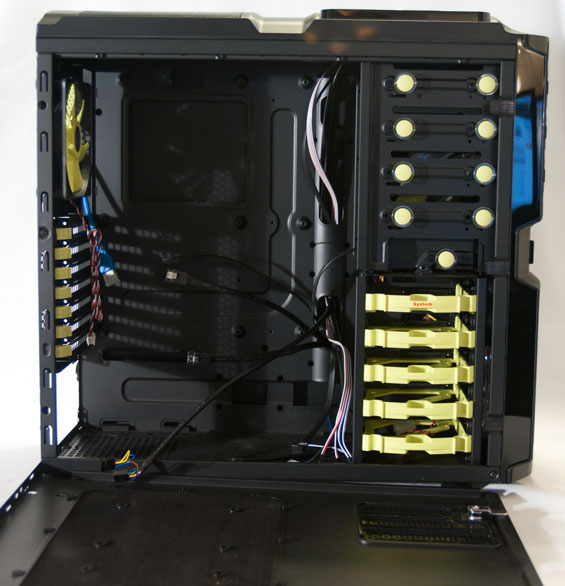IN-WIN BUC: Just How Much $100 Can Buy
by Dustin Sklavos on May 9, 2011 4:28 PM EST- Posted in
- Cases/Cooling/PSUs
- In-Win
- mid-tower
In and Around the IN-WIN BUC
I'll come out and say it: while I don't think it's anywhere near as ostentatious as a lot of gaming-oriented cases can be, the IN-WIN BUC could probably stand a little more understatement. There's no glossy plastic to be found anywhere on this chassis except for a light trim at the top and small side accents, though, and thankfully the lighting is in no way overpowering: the front logo glows red (this can be disabled), and the front fan glows blue. The color scheme is two-toned, with most of the case in black and assembly grommets and trays in a kind of neon yellow-green.
Build materials are the standard plastic and SECC steel one would expect in the price range, but the case feels sturdy and not liable to snap or break anywhere in particular. As we get into this, you'll see places where IN-WIN cut corners to keep costs down and generally speaking they're fairly smart with their approach.

The first thing that struck me when I started playing with the BUC was that it's a largely toolless case design. This is something I think some manufacturers even at the upper end of the field forget we actually appreciate, and what you're going to find is that there's an awful lot of thought given to practicality, ease of use, and flexibility when it comes to this case. The front covers for the 5.25" bays all snap in and out relatively easily, but they're secure enough so they don't rattle and have a squeeze-clamp kind of design that I actually prefer to the drive bay covers I've seen on more expensive cases like Antec's P182/P183 and Corsair's 600T. Practicality is king here.
When you go to open the case up, you'll find that instead of even thumbscrews, IN-WIN has adopted plastic clamps that work surprisingly well. If these aren't to your taste, you can remove them and just use conventional screws/thumbscrews to secure the panels. What I was really pleased with, and a couple of you are going to nod knowingly, is the fact that the side panels slide on and off with a minimum of fuss. I've used a few inexpensive cases where side panels didn't line up quite right or required a lot of force to budge once they were stuck in place.
The main side panel also features ventilation and mounts for two 120mm fans; clearance in the bottom mount is fine for video cards, but there wasn't enough room to put a fan in the top mount with our Zalman CNPS9900 CPU cooler attached. There's a smaller removable piece in the bottom right of the panel that uses a conventional case key; this gives you access to three of the hotswap bays. NewEgg cites the enclosure as having four bays, but that's not entirely true; only the first three can be accessed with the door and the fourth is only accessible if the entire side panel is removed.

Popping open the BUC reveals a largely toolless interior. 5.25" drives are secured by popping out the neon green knobs, sliding the drive in, and then popping the knobs back in--and you only have to do this on the main side of the enclosure. There's a single knob for the external 3.5" bay, and then there are five 3.5" drive trays, four of which connect seamlessly to a SATA backplane.
The motherboard tray has the standoffs for a full ATX board more or less built in, and amen to that. It's been a long time since I've seen a motherboard that uses any kind of nonstandard standoffs, so not having to install those is welcome. Above the motherboard area is an opening where an additional 120mm fan can be installed; two plastic clamps flex open as you insert the fan, and then it more or less locks into place. This felt a little bit loose to me and is definitely vibration prone.
Finally, the expansion bays include one actual removable slot cover, with the rest essentially needing to be bent and snapped off. That's disappointing, but on the bright side each of these have a clamp that rotates outside of the case: no screwing in expansion cards, and our GTX 580 was remarkably secure using these clamps.
















57 Comments
View All Comments
Gigantopithecus - Monday, May 9, 2011 - link
Methodology looks very sound and I hope that Anandtech will be able to continue adding new cases to see how they stack up against each other (ha) while keeping the internal components constant.Silenus - Monday, May 9, 2011 - link
Nice to see case reviews from time to time.I'd love to see some Fractal Designs cases reviewed. Especially some of the new ones coming. I am chomping at the bit to get a better look at the Arc Midi Tower and the Arc Mini!
XiZeL - Monday, May 9, 2011 - link
mee too :) really want to know how the silent ones performe. might be changing my antec p183 for an FD define r3 or xlymrtech - Tuesday, May 10, 2011 - link
I have a define R3. and holy shit i love it. replaced my cooler master HAF 922 with this. it's quiet as hell and also keeps my innards all nice and cool. i have a noctua noctua nh-d14 on my i7-960 and it idles around 38C and my 6870 twin frozr with fans at 40% idles around 34C. considering the noise it DOESN'T make, the price, the quality of the materials used, and the overall workmanship. i would reccomend it to EVERYONE.another good case to check out is the fractal design core 3000, it's like 90$ tax and shipping in (ncix) and it looks pretty top notch.
Mumrik - Monday, May 9, 2011 - link
I'd rather have had one and eight or nine internal 3½" bays...I have one optical drive that I never use and six harddrives and only more to come.
SquattingDog - Monday, May 9, 2011 - link
Clearly you've never used hot-swap bays then or thought about the fact that you can mount 4+ 3.5" drives in the space of 3x 5.25" bays with a 120mm cooling fan to boot (Lian Li do such a product and are not the only ones). Personally I would rather have seen FOUR 5.25" bays for this very purpose. Otherwise you can always get single hot-swap bays to go 5.25" --> 3.5".It's about different horses for different courses really - perhaps you should be looking at an eATX full tower instead?
Other food for thought, as I have been down this road before: if you have drives which are <2TB (hell, even if they are 2TB - you can now get 3TB drives), then secure erase and sell off your old drives and buy fewer larger drives. :)
Taft12 - Monday, May 9, 2011 - link
You can't have enough 5.25" bays. SATA can be hot-swapped, take advantage of this great feature!http://www.newegg.com/Product/Product.aspx?Item=N8...
(shameless plug, not associated with iStar, just a very satisfied customer!)
bji - Monday, May 9, 2011 - link
Just curious ... how much content do you have to steal to fill six harddrives?I personally have never filled more than 30 gb or so of a disk; I could see filling maybe 100 GB tops if I kept all of my home movies and photos on my local disk instead of in the cloud. I guess if you're a real 'power user' and buy lots of software and games maybe you'd fill another 200 GB? I just can't imagine filling more than 300 GB unless you're stealing content. Of course I know that there are the exceptional case where someone has, e.g. a photography business or something and they need to store terabytes of data legitimately but ... somehow I doubt that every person I see complaining about, e.g. the small size of SSDs, or the inability to put more than 6 hard drives in a case, has a legal use for all of that space.
On the upside for me, I am perfectly happy with a single 80 GB Intel SSD in my desktop and will be for years to come. SSDs are now in the price range where for my usage, they are cheap enough and are only getting better as they get faster.
Klinky1984 - Monday, May 9, 2011 - link
Oh yes, they must be stealing content. No one ever backups their DVD or BR collection, no one ever edits HD video. No one ever has thousands of high resolution photographs or large photo editing project files to deal with. No one ever has hard drives to put in a RAID setup for performance or redundancy reasons. Yep, must be stealing content, because _you_ can't think of any legitimate use.Shall we just make it illegal to own multiple hard drives?
JarredWalton - Monday, May 9, 2011 - link
For the record, just my AnandTech folder for the past four years checks in at a respectable 70GB. Add in my personal pictures and that's another 30GB. I just upgraded cameras and can now shoot 1080p24 video, which only chews up around 1.3GB for a 10 minute clip. Since the start of 2011, I've only sucked down 13GB with home videos of my family, and I don't even shoot video more than a few times per month!My desktop has a 1TB hard drive that is around 70% full, because I happen to play games on it. My Steam folder currently sits at nearly 200GB, and I haven't even installed most of my Steam games on this system (e.g. I don't have the original Half-Life, or the various HL2 episodes, installed). Honestly, I can't even get by with less than 256GB of storage on a system that I plan to use for "everything", which is why SSDs are tough to use on a single drive laptop.